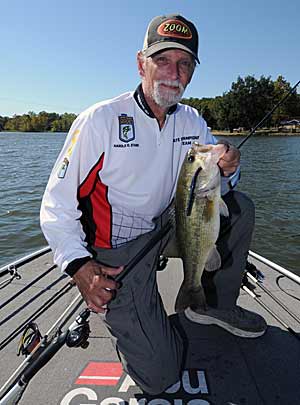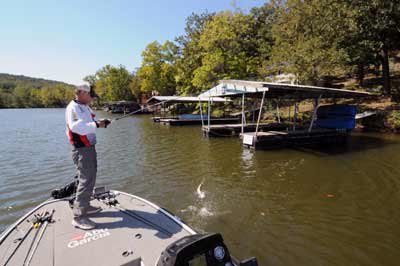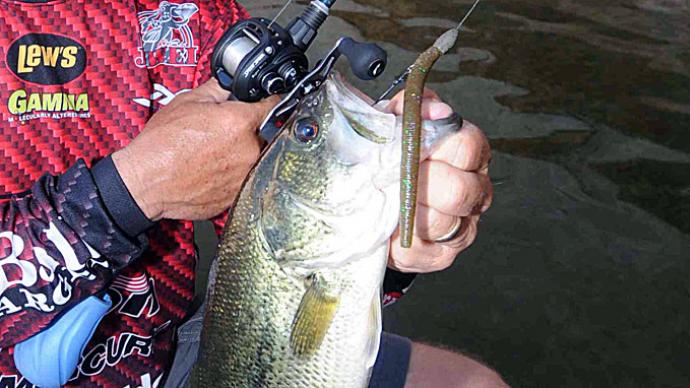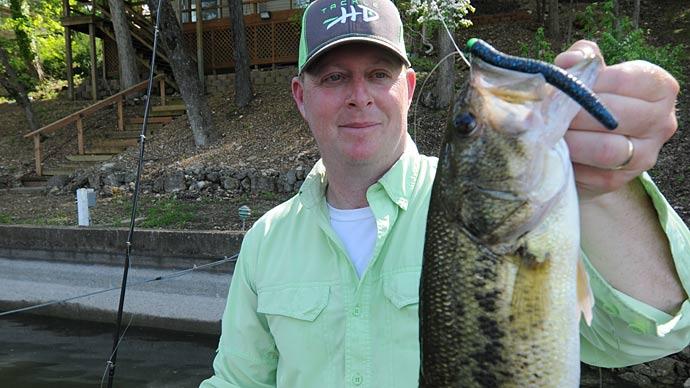
The fall feeding spree for bass prods many anglers into throwing high-action, fast-moving lures at aggressive bass.
However, there are times in the fall when bass become moody and want something easy to catch. That’s when tournament veteran Harold Stark relies on the slow-moving, simple-looking stick worm (also commonly referred to as the Senko) to trigger bites. “In the fall, bass are looking to feed and are in transition,” Stark says. “A lot of times, the fish are in a very negative mood depending on the weather and all the other circumstances in the fall of the year.”
Fall scenarios such as high-pressure days after cold fronts and lake turnover are prime times for Stark to throw a stick worm. “It is unobtrusive,” he says. “The Senko is just slim and easy to fish. It seems like anything long and skinny will attract a faster bite.
“The greatest thing overall about a Senko is that it has minimal built-in action,” Stark says. “The bait will quiver whenever it falls on a wacky rig or pitch it weightless. Otherwise, when you put it on a Texas rig or a shaky head, you have to give it the action you desire. You can use it so many different ways, but the biggest deal is that it has no action, so I can throw it out there and deadstick or move it slow like any natural thing on the bottom.” The former B.A.S.S. Nation Championship qualifier believes the stick worm imitates any creature that moves slowly along the bottom and is an easy meal for lethargic bass.
“It is also a great follow-up bait when the bass are active,” Stark says. “If the fish miss your moving bait, you can follow up with that Senko and have a shot at catching that fish that missed your Whopper Plopper or your buzz bait. It is just a great all-around lure for the fall time of the year.”
Heavy fishing pressure will also prompt Stark to choose nondescript stick worms such as the Yamamoto Senko or Yum Dinger over livelier soft plastics featuring wiggly tentacles and tails. “That is the whole key is that it looks like nothing,” Stark says. “Remember the old Charlie Brewer Do Nothing Worm? That thing caught lots and lots of fish, and (the stick worm) is a modern version of it on a Texas rig. You can throw it anywhere you want to throw it.”
The Missouri angler likes throwing the stick worm around targets from the bank to 20 feet deep. Some of his favorite targets include shallow brush piles, logs, back sections of docks, and dock walkway floats.
Stark opts for 5-inch black-and-blue or green pumpkin Dingers most of the time in the fall to imitate bluegill. He favors Dingers in the morning dawn hue when fishing in clear water highland lakes containing spotted bass.

The Missouri angler sometimes attaches his stick worm to a drop shot rig when fishing clear highland lakes, but when he fishes his home waters of Lake of the Ozarks, he prefers Texas-rigging it with a 1/4-ounce worm weight and either a 2/0 or 3/0 Eagle Claw Lazer Sharp worm hook. “If you throw it on an extra wide gap hook, it tends to spin, and you get a lot of line twist,” Stark says. “The J-shaped worm hook seems to come through the water much smoother, and you don’t have any problems hooking up fish with it because the hook is super sharp, and the bait is soft.”
Stark pitches or skips the stick worm on a medium-heavy action 7-foot, 6-inch Lew’s Custom Speed Stick and 7.1:1 gear ratio baitcast reel filled with 15-pound Seaguar Red Label Fluorocarbon line. “I am generally fishing behind a dock or in the brush, and I am trying to skip the bait and then move it slowly on the bottom,” he says. “When I am skipping it behind a dock, once it leaves two or three feet from the cover, I crank it back in and make another presentation. Generally, the fish will hit it on the initial fall or the first two movements of the bait.”
When keying on shallow water targets, Stark lets his stick worm fall on a slack line and limits his movement of the lure. “I just lift my rod tip and try to make the lure glide across the bottom,” he says. “I don’t want a lot of action with it.”
Stark also relies on the Senko after he has made some unsuccessful casts with moving baits, such as a buzz bait or square bill crankbait to a shallow log or brush pile. “If the bass didn’t want your buzz bait, the buzz bait might have gotten the fish active, and as soon as you drop that Senko in there, you can get a bite on it,” he says.
If a bass swipes and misses his moving bait, Stark follows up on the next cast with his stick worm. He casts to the spot where the bass misses his lure and lets the stick worm fall to the bottom. After deadsticking it for as long as 30 seconds, Stark slowly moves the worm 2 or 3 feet along the bottom to trigger a strike.
Stark suggests the stick worm is the ultimate last resort, go-to bait for fall bass fishing. “When things have gotten tough, you can pick up that bait and go to work,” he says.
BassResource may receive a portion of revenues if you make a purchase using a link above.




